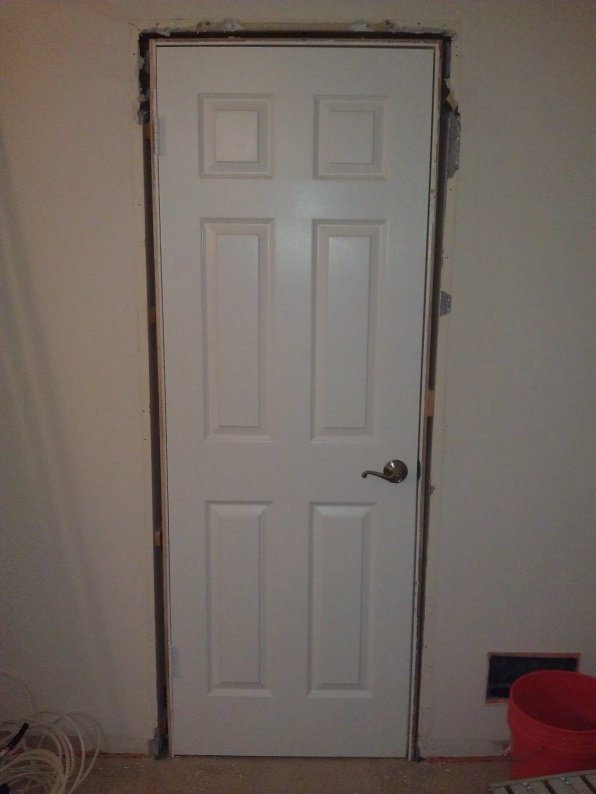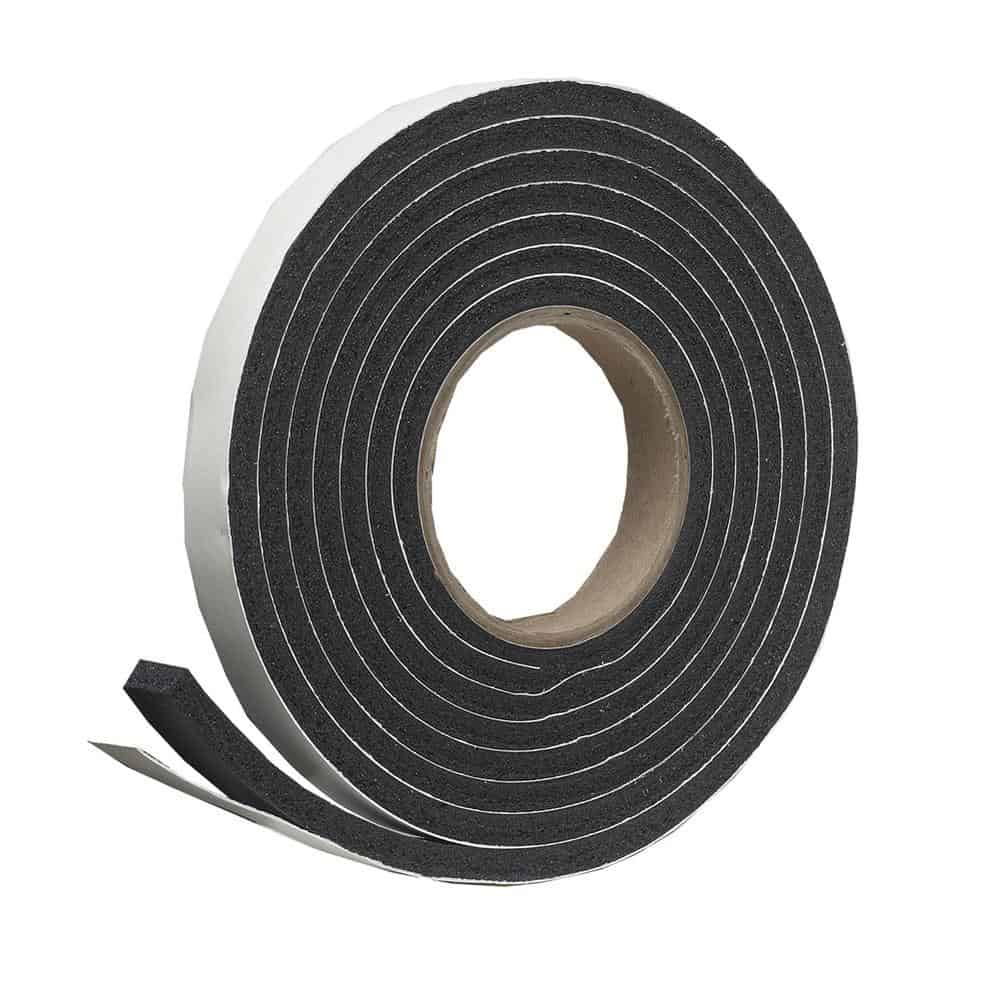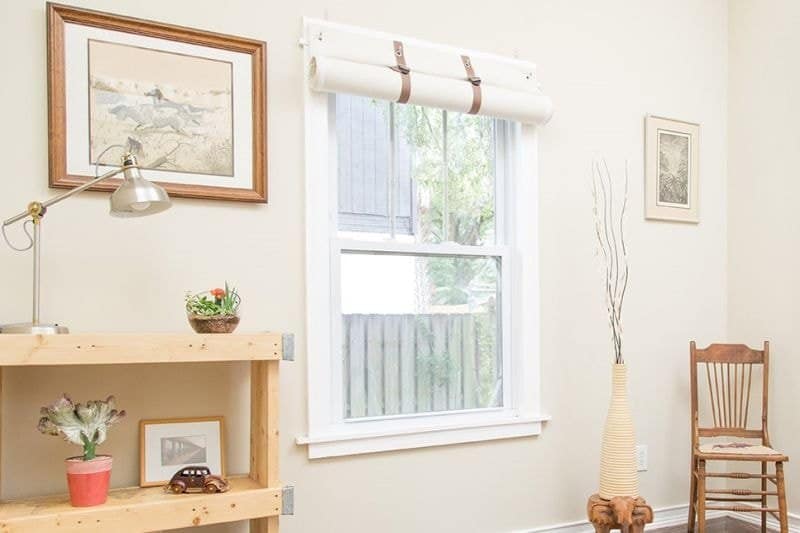Are you tired of constantly hearing footsteps and conversations across your door?
Well, after moving into a new apartment, I certainly was.
That is when I decided to take matter into my own hands.
Most homeowners—even the most passionate DIY ones—tend to ignore doors when it comes to soundproofing because they think it can get a little pricey.
But here’s the good news.
Soundproofing a door doesn’t have to be expensive. To prove that, I have listed down X ways to soundproof a door without having to break the bank.
Things You Will Need: At a Glance
1. Begin With Sealing Partial Gaps & Cracks in the Door Frame

The gaps between your door and the wall can easily let in sound. I highly encourage you to start with plugging the gaps around the door frame.
The reason?
This method is quite affordable and doesn’t require much expertise.
First, let’s begin by locating the gaps in the door frame. Sometimes, the gaps are too small to be visible to the naked eye. Here’s a simple way to locate the leaks in the door frame:
- Turn off all the lights in the rooms surrounding the door.
- Ask someone to stand on the other side of the door. Have them shine a flashlight or a torch around the edges of the door.
- The cracks will let some light through. Make a note of these places as this is where sound can travel through.
I used this insulating foam sealant to fix these leaks with ease. It forms a permanent weather-tight seal and has great adhesion to building materials. It’s also paintable so you can paint it so that it blends in perfectly with your door.
If the gaps are smaller (less than 1 inch), I recommend using this small gap foam instead. After using it, in an hour or two, the frame leaks should be permanently sealed.
2. Use a Weatherstripping Tape

A weatherstripping tape helps you seal the gap between your door frame, just like the acoustic sealant above. However, the main benefit of weatherstripping is that it’s extremely easy to apply and remove whenever you want.
There are different forms of weatherstripping tapes available on the market such as rubber, vinyl, foam, metal, etc.
So, which one should you get?
In my opinion, you should get one depending upon how long you expect it to last. You might also consider selecting a color that matches your doorframe.
As a general rule, metal stripping is the most expensive but has enhanced durability. It can last more than 30 years on your door. If you don’t plan to move houses anytime soon or are looking for a permanent solution to soundproof your external door, I’d recommend you invest in a metal weatherstripping.
In comparison, vinyl stripping is a little cheaper. It isn’t everlasting as the metal one, but it’s usually pretty easy to install—thanks to its adhesive strip. Here’s the vinyl weather stripping I recommend you get.
If you’re looking for something durable and that isn’t too heavy on your wallet, you might want to settle with a rubber material.
Foam tape is usually the cheapest, but it doesn’t last more than two years or so. I tried installing it on my bedroom door. It looks a little obtrusive but works well though. Here’s the foam weatherstrip tape that I would suggest you buy. It sticks well, compresses easily and fills out again once the door is open.
No matter which one you settle with, make sure to use compression stripping. It is this compression that forms an airtight seal and helps you block unwanted noise from the door.
3. Install a Door Sweep
Although weatherstripping helps in insulating your doors, you’d notice that there’s still some open space beneath the door—which weatherstripping doesn’t help with.
Is there something you can do about it? Heck yes!
Weatherstripping combined with a door sweep is a very effective door soundproofing solution.
A door sweep does exactly what you’d expect: It creates a seal between the door and the floor–which helps eliminate sounds.
I recommend you try out this door sweep. The thick rubber material provides a great seal.
You might need to trim it down a bit to fit perfectly. I didn’t have anything handy to trim it down, so I bought this inexpensive utility knife.
There are numerous other indirect advantages to using door sweeps. Alongside blocking noise, it also keeps away cigarette smoke, dust, and small insects. If your room is equipped with an air-conditioner, it will help you prevent cold air from escaping. This will help with energy efficiency and help reduce electricity costs.
One thing I learned the hard way is that door sweeps damages the carpet. So either you want to avoid laying out the carpet, or you can try using a better alternative to door sweeps like the acoustic threshold. In hindsight, I’d prefer to combine both of them for the most efficient sound blocking possible.
4. Install a Door Gasket
If you’re looking for something more effective than weatherstripping, you should opt for door gaskets.
Magnetic door gaskets cost a bit more than weatherstripping but are much more efficient than weatherstripping when it comes to ensuring airtight sealing.
One important thing to note is that magnetic door gaskets work only if your door has a magnetic strip. If you are willing to change your doorframe to a metal frame, I would urge you to opt for gasket rather than weatherstripping. It isn’t exactly DIY-friendly for the newbies but usually works much better than weatherstrips.
If you would like to try one, I suggest you check out this magnetic door gasket.
5. Mass Loaded Vinyl (MLV)
One major problem with interior doors is that they do not have any substantial mass. This hollow nature of the doors means that they amplify noise and vibrations heavily.
If your problem is mostly sound vibrations than airborne sounds, I’d suggest you get Mass Loaded Vinyl (MLV). It is a thick roll of vinyl that helps you increase the density of your door.
MLV comes at a price, though. As WikiHow notes, you’ll likely spend at least $2 per square foot on low-quality MLV. The cost increases for thicker barriers. While cheaper mass loaded vinyl is available, my experience has been pretty sub-par with low-quality MLV.
I’ve found that it’s better to grab a higher-quality mass loaded vinyl such as this one. It’s a little pricey, but you get the absolute best protection.
After you buy it, you will need to attach it to the door. You can easily do this using construction adhesive, which you can purchase online for cheap or at your local hardware store. In my experience, using double layers of MLV gets you the best results.
If you are looking for a cheaper alternative to MLV, you can try MDF.
Ensure that the MDF board is at least 1 cm thick. Here’s a great MDF board which is thick enough for soundproofing. It isn’t the most aesthetically pleasing material or even the most effective, but it can get the work done even if you’re on a budget.
Once you’ve added either the MLV or MDF, ensure that you seal the frame completely as described in the above section.
6. Soundproof Blankets
If you’re looking for a temporary solution to soundproof your door, a soundproof blanket is your best bet.
Here’s why.
“Installing” these blankets is as simple as hanging them onto the hooks at the back of your door. This way, you can put them up when you need and remove them when you don’t.
Soundproof blankets are made of fiberglass—which is a great sound absorber.
Alternatively, you can also use moving blankets to stop the unwanted sound. For the uninitiated, these are the blankets used by movers to wrap the furniture so as to prevent them from getting damaged. As you’d expect, such blankets are pretty thick—which is exactly what we need. It’s a surprisingly effective way to soundproof a door.
Here’s a great acoustic blanket you can get. Each individual blanket weighs nearly 4 pounds, which will help these blankets absorb outside noise. The only issue is that this blanket lacks grommets, so you’ll need something strong to mount them on.
If you would like to make hanging the blankets hassle free, I suggest buying a blanket with grommets. Remember those small rings on the curtains? Yes, that’s what grommets are. They will make hanging and removing those blankets much easier.
One obvious downside is that all these blankets might not fit in well with your door frame aesthetically. So you might consider using it on interior doorways that aren’t as visible in your home. But hey, you can remove them whenever you want, right?
7. Soundproof Fiberglass Panels
If you’re ready to take your soundproofing game to the next level, you can buy a fiberglass panel instead of a soundproof blanket.
They are a bit heavier and more effective at absorbing sound that blankets. They not only ensure the sound is blocked, but also absorb the sound so there’s less echo inside your room.
If you’re willing to shell out a little cash, a fiberglass panel is a simple yet effective option when it comes to soundproofing a door.
These Singer Safety Fiberglass Panels have brass grommets on all four sides, which allows you to be a little more versatile with how and where you hang them.
8. Soundproof Curtains

Curtains are common-sight on windows. However, its also possible to use these curtains on your doorways too.
For best results, I’d suggest you go with thick, multi-layered soundproof curtains. The thickness will help dampen the sound. Also, you have the liberty of choosing any colors that match with the existing room setup.
If you’re looking for ideas, I found this great soundproof curtain on Amazon. Nicetown offers curtains in a wide range of prices and designs—so you’re bound to find one you love.
Before you can install acoustic curtains, you will need to install the rods above the door frame. It’s pretty easy and should really take much time anyway.
As you might expect, curtains are nowhere as good as soundproof fiberglass or even blankets. But if you’re looking for a visually pleasing option that won’t burn a hole in your pocket at the same time, you might consider buying a soundproof curtain. It’s also a great temporary solution.
9. Soundproof Paint
Soundproof paint can help bock low-pitched noise up to 30%. Admittedly enough, the impact is nowhere as significant as other methods that we’ve discussed.
I’m including soundproof paint at the end because of just one reason. It’s cheap and without any hassles. You can choose any color to match your home decor. You can get one easily at your nearest hardware store. Here’s a good soundproof paint if you’re looking to buy one.
However, I would never recommend using soundproof paint as your sole soundproofing method. It’s best to use it in combination with other methods on this list.
10. Purchase a New Solid Door
If you’ve tried a few of the fixes above, you should have gotten some pretty great results. If you’re willing to take it one step further, you might even considering a new solid door. This is a pretty extreme measure, but the difference is strikingly noticeable.
Most doors used in the house are pretty hollow, which makes them a sound amplifier.
If you’re looking to purchase a new solid timber door that is soundproof, here are some tips you should consider.
There are different types of solid core doors available. Hardwood is a little pricier, but is great for soundproof-ability. Medium Density Fiberboard (MDF) which is a little cheaper but less efficient way to block airborne sounds.
So how do you decide which material is the best?
It’s pretty easy.
These materials have a Sound Transmission Class (STC) rating. Essentially, the higher this number, the more effective is the material at blocking out the noise. Generally speaking, a door rated 30-40 STC should be good enough for most people. As you’d expect, the price increases as the STC rating increases.
Get Rid of the Noise by Soundproofing Your Doors!
If you’re keen on purchasing a new door that doesn’t burn a hole in your wallet at the same time, I’d recommend you to pair your new door with at least a couple of the solutions described above. This way, you can get away with buying a lower-rated STC door and save some money, while still, have a decent soundproofing set-up in place.
If you’ve any more questions, please drop them in the comments below. I will be happy to get back to you!
To recap, if the layout of your home allows it, you can try moving your furniture around a little to see if it helps. If that isn’t feasible or if it hasn’t helped much, you can try using acoustic caulk, weatherstripping tape, a door sweep or door gaskets to seal the gaps in your door. Foaminsulation, curtains, and blankets are also on the table. For a pricier, but a more effective job, consider soundproof fiberglass panels. And, lastly, if nothing’s done it for you so far, you can always replace the door entirely.
